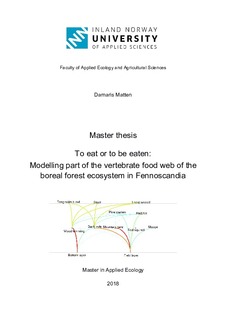| dc.description.abstract | Trophic relationships, amongst others, define the structure of an ecosystem. They are mostly
simplified and described as plant-herbivore and predator-prey interactions. Modelling trophic
interactions are one way to improve our understanding of the functioning, impact and management
of ecosystems.
In this study, I explore how the cyclic vole and lemming populations affect the dynamics of the
boreal forest in Fennoscandia. Specifically, I ask what mechanism controls the food web in years
with peak and low densities of small rodents, the impact of small rodents on primary producers and
how predator densities influence small rodents. To strengthen the conclusions, I test how robust the
models are to ± 20% changes in parameter values.
To answer these questions, I applied Ecopath, a mass-balance modelling approach, to explain
trophic relationships in a system. The main output of the model is Ecotrophic Efficiency (EE), a
measure to capture the consumed production of each trophic level. I modelled the vertebrate food
web primarily connected to the cyclic voles and lemmings in the boreal forests, and built models
according to their cycle phases. This is the first time this boreal forest community is modelled using
Ecopath.
The models showed a top down control on the bottom layer (mosses, lichens and fungi) in peak
rodent years. The densities of small rodents would need to increase 16 fold from observed densities
to negatively affect the field layer (shrubs, herbs, grasses and grass-like species). Predator density
would need to increase 4 times to be able to control their prey. In addition the model were robust to
parameter changes up to 20%.
The system shows a strong herbivore-plant interaction in peak rodent years, but in low rodent years
no control mechanism was apparent, indicating surplus resources for all components of the food
web. Small rodents, specifically lemmings, deplete the bottom layer (mosses) in peak density years.
Predators seem to only have a minor influence on the cycle dynamic. With this model approach a
first systematic picture of the boreal forest community is captured, which to some extent coincides
with hypothesis on small rodents population dynamics. | nb_NO |
